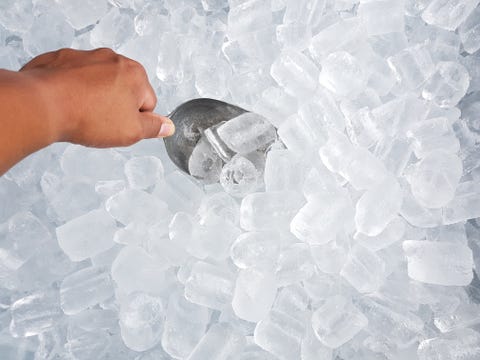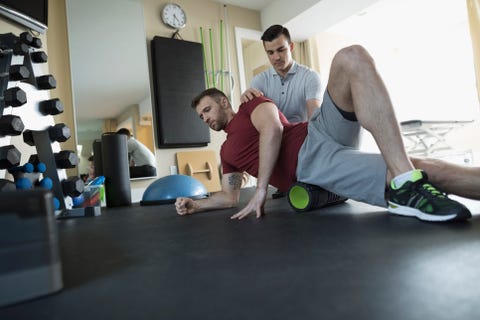Pull Your Groin? Here's How to Treat It.

It’s one of the most uncomfortable moments you can have in the gym: An awkward landing, a pop, and the painful sensation that prevents you from squatting, running, and even walking normally. You’ve strained your groin — but do you really understand how or why you’ll want to ice around your junk for the foreseeable future?
Groin strains are among the most common type of muscle strain, but they can be particularly annoying due to their location. A groin strain refers to a set of five different muscles, also known as the adductors, that help adduct (bring in towards your midline) the thigh and stabilize the hip. These muscles are most strained with activities such as jumping, sprinting, leaping and in any activity with single leg pushing or cutting such as football, skating and skiing.

Getty ImagesOlegPhotoR
The adductor muscles include the adductor magnus, adductor longus, gracilis, adductor brevis, and pectineus. Most of these muscles originate from the pubic bone and attach along the inside of the femur or thigh bone. When strained, a person can feel a sudden sharp pain right along the groin line, at the pubic bone or along the inner thigh, depending which muscle is most affected. The pain can feel worse when the legs are separated, stretching the muscles, and relieved when they are closer together.
Making the Strain Grade
There are different grades of muscle strains.
If you suspect you may have a groin strain, follow these steps:

Getty ImagesPraphan Sanstongngam / EyeEm
- RICE — Your first line of defense is to rest, ice, compress and elevate. This can be hard with a groin strain, so focus on the rest and ice. Apply ice for 10-15 minutes to the affected area a few times a day.
- Avoid aggravating the injury site. When there is a muscle strain, fibers have been torn in the muscle and the body needs to heal itself. Avoid straining this area by stressing it more to allow the healing process to occur.
- If you have trouble walking, see a healthcare specialist such as an orthopedist, sports medicine doctor or a doctor of physical therapy. An MD can order an MRI to fully assess the soft tissue damage. You may need crutches to avoid loading the muscle if completely torn.
Treating Your Strain Pain
What to expect from treatment:
Depending on the grade of the tear, it is likely you will have to temporarily stop exercising and straining the muscle to accommodate the healing process. A physical therapist will be able to guide you through the appropriate rehabilitation process, incorporating soft tissue mobilization, gait training, gentle range of motion and stretching exercises and a progressive strengthening routine.

Getty ImagesHero Images
Other modalities such as ultrasound, electric stimulation, ice and heat may be used throughout the process. A physical therapist will help to get you back on the road to recovery. If it is a complete tear, however, you may need surgery to reattach the muscle. This is why it is critical to seek medical treatment if you are experiencing moderate to severe pain and/or limitations in function.
Expected duration:
Keeping Your Groin Safe
How to avoid muscle strains:
While most groin strains happen suddenly and aren’t completely avoidable, it’s always good to be mindful of your movements and body mechanics. Make sure you have a complete exercise regimen that addresses all the large muscle groups throughout your training regimen. If you are not sure if you have a small or large tear, see a medical professional sooner rather than later.
Source: Read Full Article
